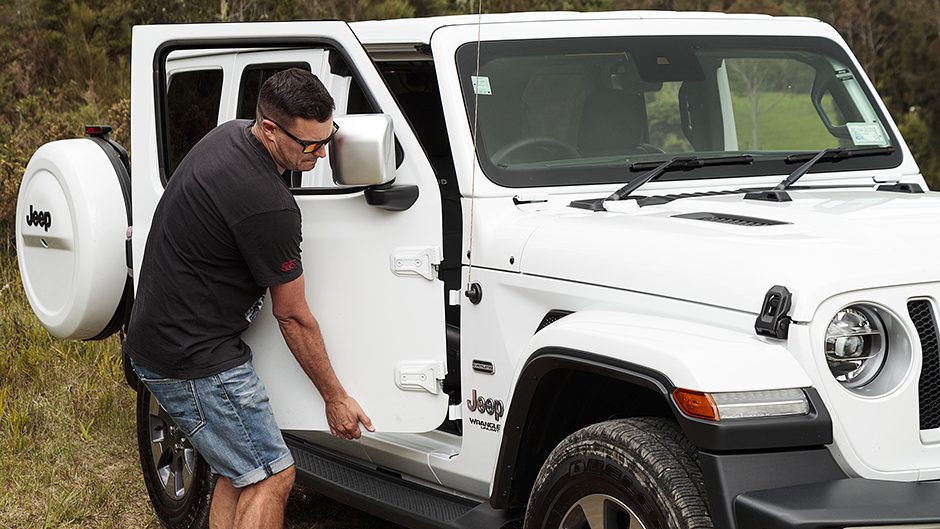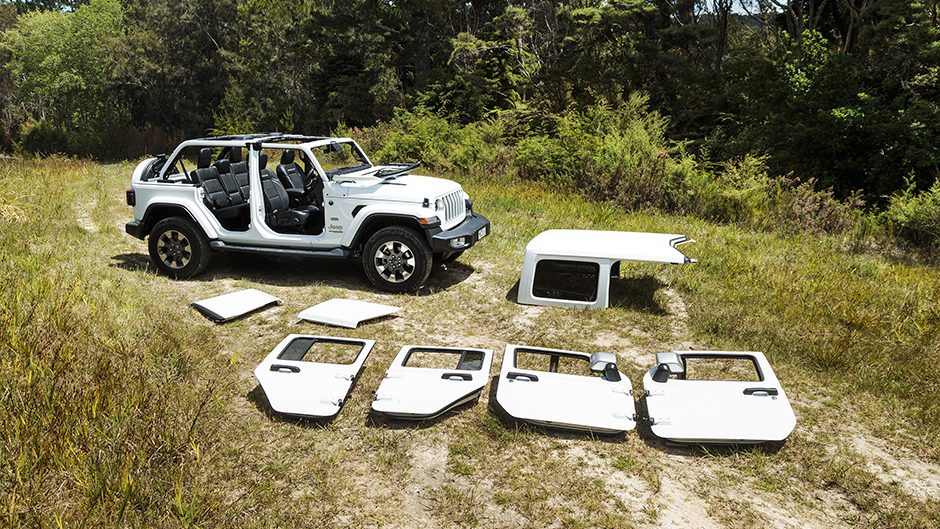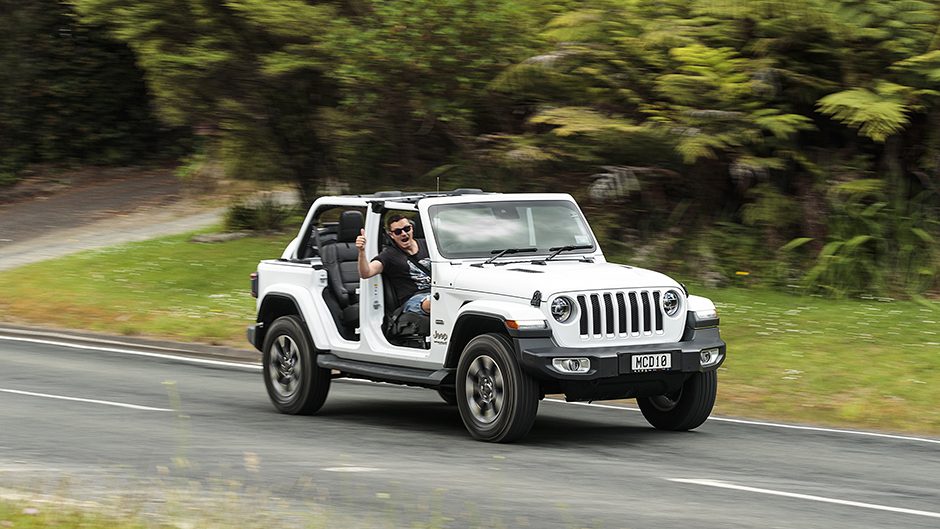There are plenty of ways to have fun in a vehicle, even when you’re parked up. Remove your thoughts from the gutter people; this is a G-rated publication (apart from the odd Pacenotes column perhaps). Jeep’s Wrangler Unlimited is unique in being a four-door convertible. While we’ve bashed around the bush in it a few times, one thing we haven’t done with a Wrangler is remove the hard top, which provided a bit of fun for a Friday.
We’d heard it was a rigmarole on the old model, so never bothered. However, after watching a few ‘how to’ clips on YouTube, we felt empowered. The first step is to check the weather forecast, looking for a big high in your area. The Overland, tested here, only comes with a hardtop so once you’ve committed to going topless, you’re all in. To hasten removal, Jeep provides a neat little tool kit with a ratchet and the exact bits required. We started with the doors, the two bolts in the exposed exterior hinges loosened with the T50 torx bit (T50 being stamped on the hinge so you can’t muck it up). Just mind the ratchet on the bodywork as the clearance is minimal. Probably the most difficult part of the whole procedure is unfastening the electrical harness for the doors, the clip particularly stiff, but the new lightweight aluminium doors are easily lifted off their hinges.
The Unlimited models come with the Freedom Panels covering the front seats to provide some open top driving without having to go the whole hog. These are a more secure fit on the new Wrangler thanks to extra latches, and Jeep’s provided a bag to help store them, which fits in the boot. With those removed you can get to the two bolts securing the hardtop to the roll bar, while there are a further six to remove in the boot area. Under the floor in the boot, Jeep has provided 16 holes to store all the bolts so there’s little excuse for losing them. Roof removal is a two person job, but there’s no need to chow down on a tin of spinach in order to whip it off, the top being relatively lightweight in the scheme of things. Certainly it is far lighter than a hard tonneau cover for a ute, for instance. Once everything has been removed, the tricky part is finding somewhere to store them out of harm’s way.

But we weren’t done yet, for we had to fold the windscreen down, if only for completion. This is an easy enough task, the wipers coming off with a little persuasion and once you have unscrewed the four bolts, the screen flops forward onto the bonnet. Unlike the previous Wrangler, the JL has a fixed A pillar and header rail, so that when you drop the screen, you still have the frame around the top meaning it doesn’t have quite the same effect. It’s therefore a bit of a gimmick, a throwback to the Willys. There’s no way to secure it either, so we reckon it would bounce around on the move. Plus I didn’t want to get bugs in my teeth while driving, so we reinstalled it.
Driving the Wrangler naked, er, driving a naked Wrangler we mean, is a weird experience. The breeze comes at you from all directions, and the lack of tin between you and the surrounding traffic feels truly odd. But it would be a boon off road for it’s easier to see exactly where the right front and rear wheels are tracking while getting in and out to check obstacles would be easier too. There’s no difference in the way the Wrangler feels on the move, the doors or roof not providing any real structural rigidity in the grand scheme of things.
So was it all worth it? Well, it didn’t take very long, about 25 minutes, which you could trim with familiarity, and as you need two people to remove the roof, another set of tools would halve the time needed. It’s probably not something you’d do often/at all with the Overland model as it doesn’t get the folding canvas roof like the Rubicon, but for topless fun on four wheels, it’s a bit of a laugh.

The Overland model gains a more sophisticated appearance with its body-coloured wheel arches and roof, and it has a hard cover for the spare wheel. It also swaps the Rubicon’s big chunky rubber for more road-oriented Bridgestone Duelers on 18-inch alloys. It’s a tad cheaper than the Rubicon at $89,990 but, like the rest of the range, has increased substantially in price in its new generation. As the luxo model, it gains plusher leather trim, heated seats and wheel and a better infotainment system over the entry-level Sport. There are just the four airbags but active safety gizmos like AEB, active cruise and blind spot monitoring are present.
It’s the round town version of the Wrangler but still comes with off road creds, though the hardware isn’t as hardcore as that fitted to the Rubicon. Sidesteps are a standard feature, which allowed the kids to climb on board unassisted, something they struggled with in the Rubicon with its rock rails. There is okay room in the rear so adults aren’t going to feel cramped, but it’s not the best family vehicle ever created; a Grand Cherokee would be a better bet there. The boot is big enough but not huge, and there’s still that awkward swing gate to open first, and then the glass hatch to lift up. The rear seats fold flat in one well engineered movement if you’re after more space. Its tow rating is 2495kg.
While the wind noise can intrude on the highway, these tyres are quieter than the Rubicon’s pluggers. The Overland goes better on road too with more grip and feel on the turn. Despite the Wrangler’s additional aluminium body parts, she’s still heavy but does point better than it ever has previously. The highway ride is quite acceptable considering the underpinnings, as is its behaviour in and around town. It’s not a hulking menace in the burbs considering its capabilities with easy steering, a better turning circle than most utes and reasonable all-round vision, supplemented by a clear and wide view from the reversing camera.

The 3.6-litre V6 is unchanged but a new eight-gear auto processes the torque into more meaningful go. It makes for a more refined driveline and helps keep fuel use to around 12L/100km with a mix of urban and highway driving. The cabin quality is much improved and the seats are comfortable, though are manually adjusted (which seems odd on a vehicle costing this much!). There are still some hard plastic bits about and not quite as much storage as there should be, but the infotainment system is pretty good. Our overall impression of the Overland is that it’s the one to buy if you’re not that keen on getting your Wrangler dirty every weekend, as it’s more luxurious inside and refined around town than the big bad Rubicon, while being slightly cheaper.


